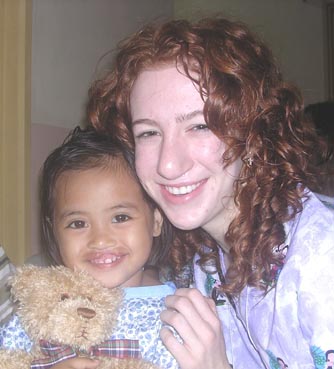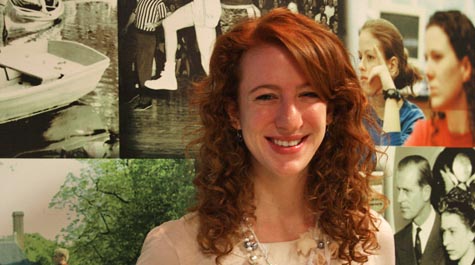Sophomore's 'Claire Bears' bring smiles to children with clefts
William & Mary sophomore Claire Crawford, born with a cleft lip, vividly recalls the eighth corrective surgery she had to undergo as a child. After a long and painful operation, Crawford, 12 years old at the time, started wondering if she was born with a cleft lip for a purpose, instead of simply wondering “why me?”
Since that day, Crawford has been helping others who, like her, were born with a cleft lips or palate. Over the years, she’s raised more than $36,000 in donations for the Cleft Palate Foundation and Operation Smile, both non-profit groups that work to help people affected with the medical condition.
Today, she continues her efforts at the College as president of the Operation Smile Student Club (OpSmile), which helps raise awareness of cleft lips and palates. The club also raises funds for existing non-profits organizations.
“One of my primary goals in making presentations is to advocate cleft lips and palates so more people will be aware of the deformity,” Crawford said. “Children with clefts are often hidden, isolated, and teased, but anyone with a cleft lip and palate can overcome the deformity and succeed if given the opportunity.”
Cleft lips and palates are a medical condition where a child’s upper palate (the stretch of bone that lines one’s upper mouth) does not develop properly during the pre-natal stages. The condition is marked with an opening of the lips, called cleft lips, and in extreme cases, the condition can result in an opening reaching all the way back through the opening of the nose, known as cleft palate.
Cleft lips and palates affect one in every 500 children in developing countries and one in every 700 in the United States. Clefts, if not repaired through surgery, can affect a child’s breathing, speaking, and eating habits in addition to the appearance of a child.
“In many countries, the children are hidden in their homes because they are so ridiculed when they step out the door, in other countries, the parents see a cleft child as a curse, a punishment for the parents doing something wrong,” Crawford said. “Children in the U.S. often feel isolated or ridiculed even though their clefts are repaired.”
When Crawford first started off her fundraising efforts at age 14, she first attempted to raise money for stuffed animal bears from the Cleft Palate Foundation. These bears, designed specifically for the CPF, artificially have clefts stitched into their mouths and are often sold to comfort adolescents going through cleft corrective surgery.
 “Once
I started giving the bears away, I understood what an impact they made on the
children and parents,” she recalls. “The children could see that someone else
was like them and cared about what they were going through. Parents also felt
assured when they realized their children would be ok, and the bears were a
great way to teach their children about clefts.”
“Once
I started giving the bears away, I understood what an impact they made on the
children and parents,” she recalls. “The children could see that someone else
was like them and cared about what they were going through. Parents also felt
assured when they realized their children would be ok, and the bears were a
great way to teach their children about clefts.”
Crawford began with the initial goal of raising $240 for 24 bears to help comfort the children at the local Mississippi hospital where she had her first surgeries. Within two months, the local community had galvanized to help her buy 240 bears, and the support has only grown in the last couple years. Her efforts have become so well known that the local hospital has begun labeling her bears “Claire Bears” after one young boy named his bear in honor of the donor.
But simply raising funds for stuffed animals, Crawford said, was too simple. She wanted to do something more. At age 15, she read about a girl who had done a mission through Operation Smile, a non-profit organization consisting of doctors that provide cleft surgeries in developing countries.
Although the process of organizing a mission was both long and costly, involving admission to several workshops and training conferences, in 2008, she was finally granted her wish and was able to assist doctors at a small hospital in the Philippines. Through this mission, she began to realize her leadership capabilities and her ability to spread her passion to others.
“As long as children are born with a cleft lip, there is a need for surgeries and support,” Crawford said. “Giving surgery to a child with a cleft gives them confidence and the ability to express themselves so they can lead normal lives. World hunger and poverty may never be eliminated, but a cleft can be repaired with a simple surgery.”
During the mission, she also brought along some of her “Claire Bears” and saw, more than ever, the positive effects that a simple teddy bear could have on patients suffering through endless operations.
“One boy, Austin, was my favorite child on the mission,” Crawford recalled. “On the day of the surgery, I went into the [operating room] with him and gave him a Claire Bear. He held my hand and his bear as he fell asleep. Forty-five minutes later, his parents cried and cried when they saw their boy for the first time after surgery. He finally had a new smile.”
Currently, Crawford is part of the inaugural year for Operation Smile’s College Council, a group of seven collegiate student leaders that are working to plan initiatives to get more students involved on the international level.
But she still hasn’t forgotten the effect that a simple teddy bear had on Austin the day he received his new smile. Every year, she and her organization help to raise funds so Crawford can continue sending more “Claire Bears” not just to the Philippines to but hospitals around the world.
“Why do I do this?” Crawford said. “If I can only change one life through all the work I do, it was worth it. I have the ability to transform lives locally and around the world. If not me, who? If not now, when?”
 Skip to main content
Skip to main content

